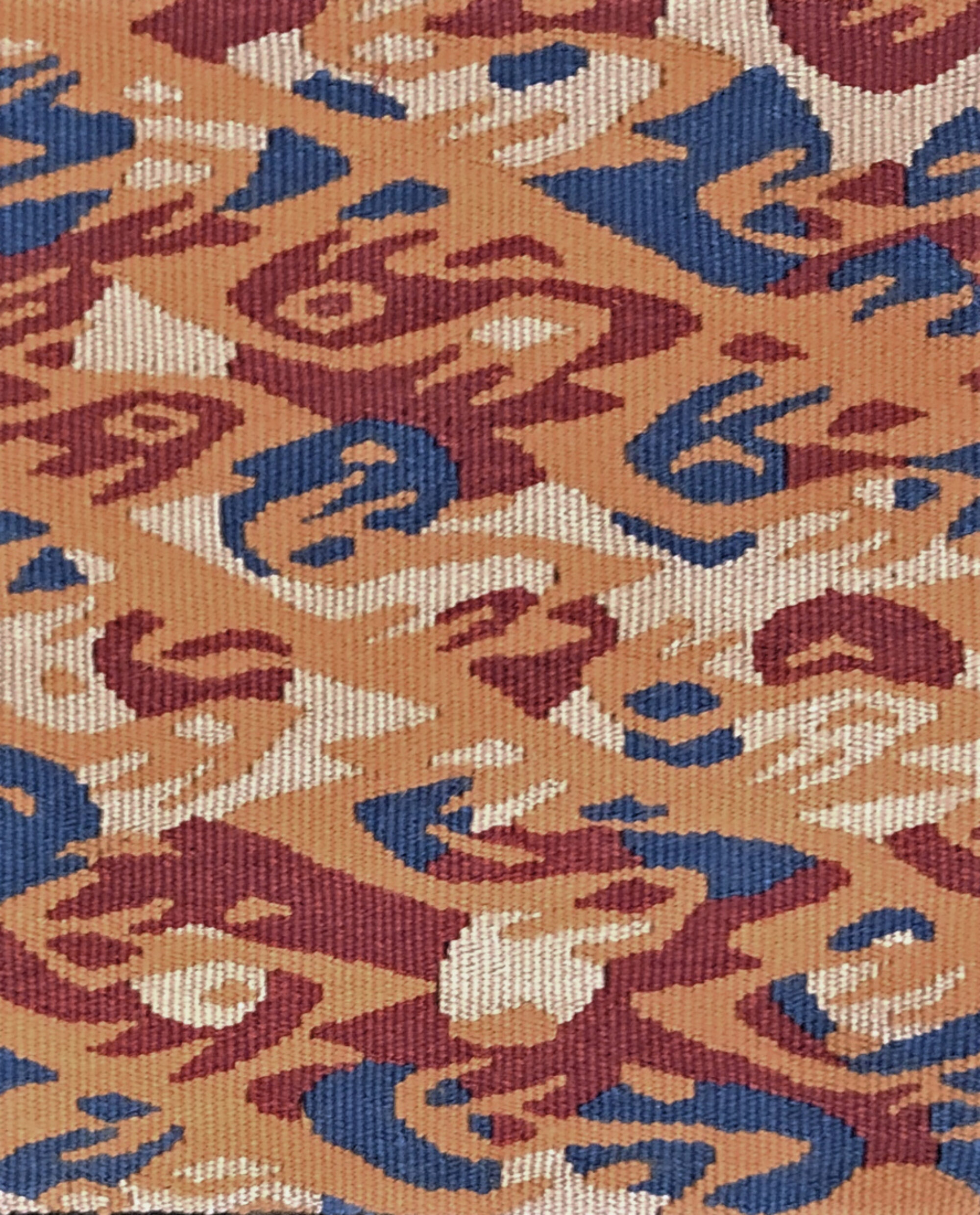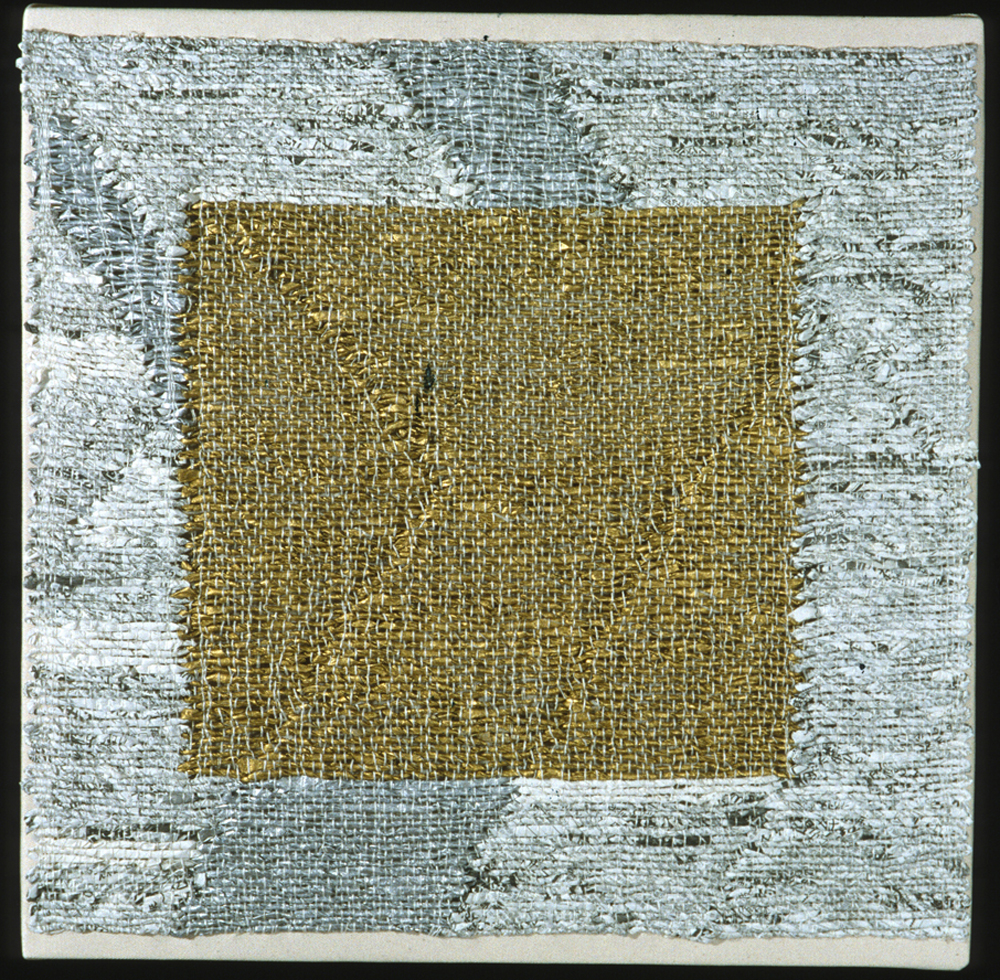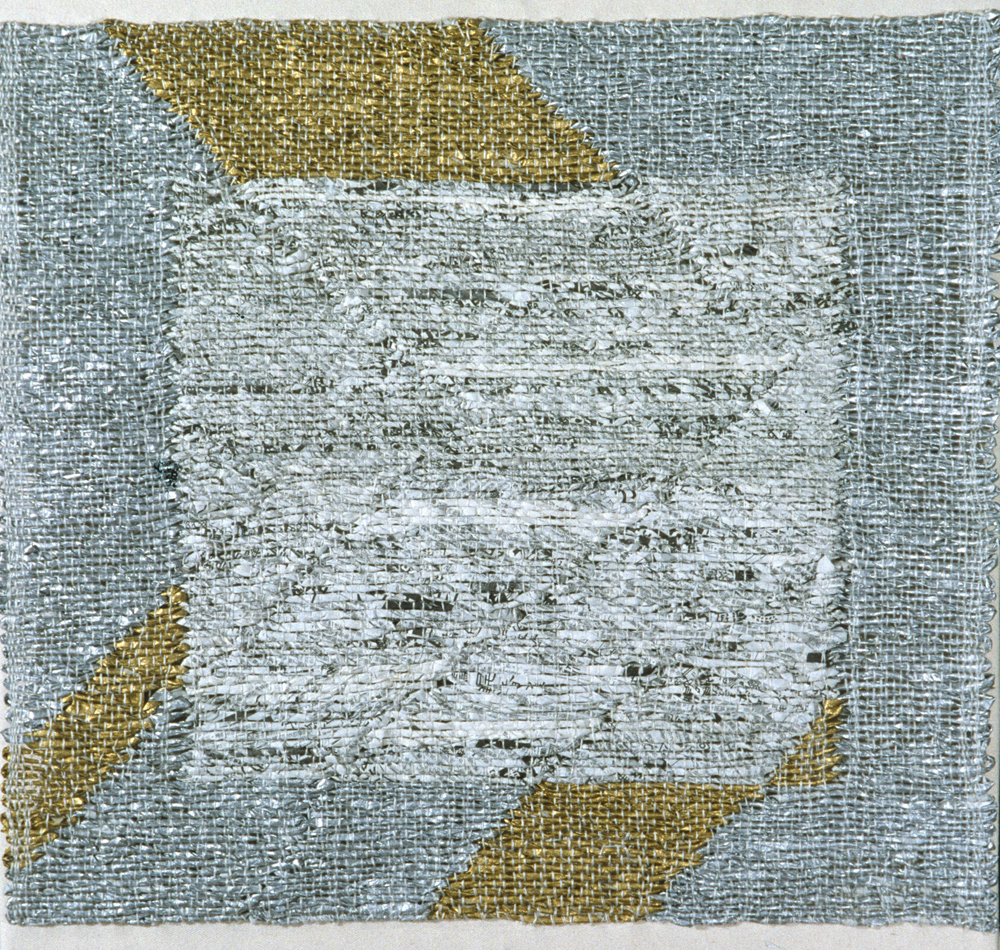This paper was originally presented at the Textile Society of America’s 2000 Symposium and then published in the Symposium Proceedings.
“We travel, some of us forever, to seek other states, other lives, other souls.”
This quote from The Diary of Anais Nin, might well describe many artists’ experience. The journey that solidifies creative impulses into aesthetic objects often involves experiences that lie outside the artist’s own culture. These other lives and other states of perception act as catalysts, generating new forms in the liminal space which travelers’ frequent. For Carolyn Price Dyer, the germane shifting cultural boundaries are those between the Western aesthetics of Modernism and the Bauhaus and the Eastern aesthetics of Asian art. Trained under the former, the latter Asian influences spring from graduate studies in Asian art history, work experience at the Seattle Asian Art Museum and travel experiences. My approach in this paper will also be based on the idea of travel, of developing a narrative path through the artist’s work, hoping neither to cover the entire diversity of her work nor every aspect of the work that I do discuss. Rather, I hope to trace certain themes in Dyer’s work as they develop over time. My own interest sends me off in search of those special cases when form and content, technique and meaning merge, working together to produce art that is both sensual and intellectual, physical and conceptual.
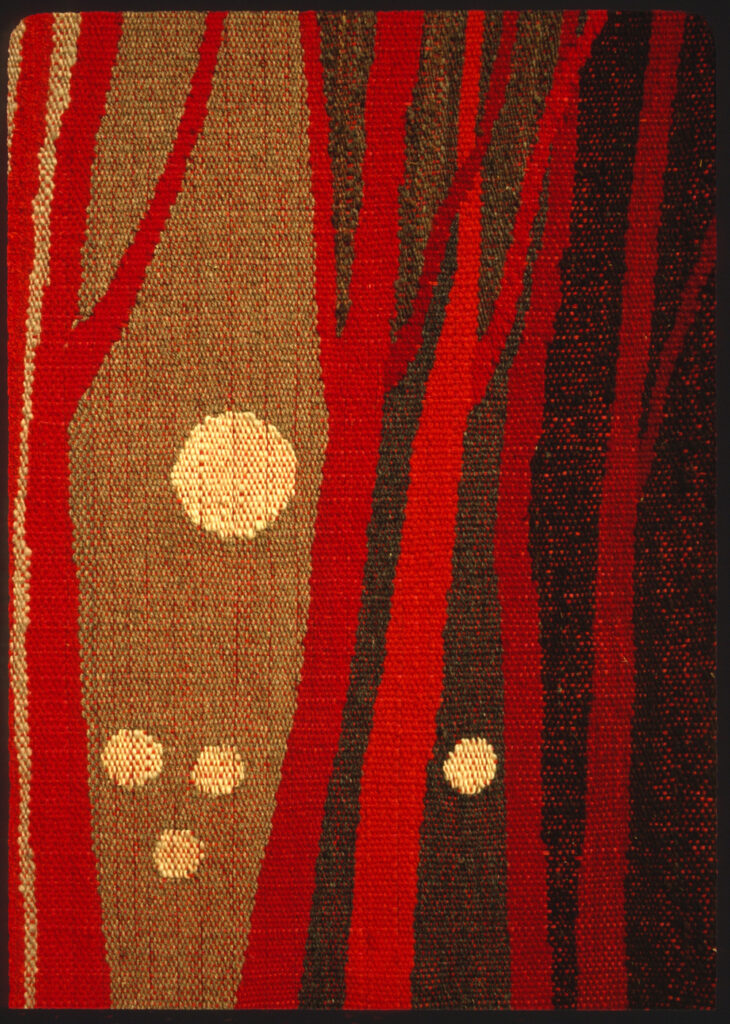
Stylistically Dyer’s work reflects her interest in Asian art, the clean lines and abstraction of Modernism and the sensitivity to materials promoted by the Bauhaus. Dyer’s spare aesthetic and deliberate compositional approach balances the energy of line, the weight of mass and the emotion of color, or color’s absence. Her work relies on the power of the materials and the suggestiveness of simplified forms to develop content. Great Forest II is an 80” x 46″ tapestry from 1982 which illustrates this aesthetic. The flattened space and abstract forms reject the idea of mimetic art based on illusionistic techniques. Instead of creating a transparent window onto the world, this tapestry calls attention to its identity as an object, a piece of cloth whose image is a product of a particular process of making.
Textile artists often speak of the importance of process in their work, comparing it to a journey. For the artist who weaves this journey starts at one point and moves in one direction. Progress is marked by the accumulation of hundreds, or even thousands, of repeated actions. The repetition inherent in the weaving process is, for many artists, meditative. Images composed of solid form and strong color, such as Great Forest II reflect the technical and material reality of weaving, the building up of shapes and the density of color. Exploiting the qualities of materials and the techniques of weaving to develop meaning in the image results in a merging of form and content. Another example of this fusion is the artist’s use of a colored warp which is allowed to peek through the weft. The colored warp highlights the texture of the weaving and adds an additional dimension to the image, sometimes reinforcing the color of the weft, sometimes subduing the weft color through the dissonance of complementary colors.
The juxtaposition of circles and lines characterizes much of Dyer’s work. Her use of these two elements has followed many paths. Lines are agents of energy, directional forces which guide our journey through the image. Circles are more static forms, in which the energy of the line turns back upon itself. Compositionally circles can create areas of density and weight or they can open up the surface by creating voids. The circle is a symbol of completion and wholeness. In Taoist thought it is the coming together of the Yin and the Yang, two complementary forces which must be united in order to achieve the perfection of the whole. The communicative power of simple forms such as the circle and the square is referred to in Signals II , a 33” x 62” tapestry from 1968. The woven shapes suggest a code, such as road signs, in which the combination of shapes and colors have specific meanings. Taken to this degree of abstraction, images become language, symbolic forms whose meaning is arbitrary and conventional.
In Japan and China the departure from naturalism and the tendency towards abstraction is considered to open up the poetic and metaphoric potential of an image. This belief develops out of the Tao, the metaphysical and spiritual ultimate which itself is completely abstract. Consequently, less naturalistic work is considered suggestive of the spiritual world.1 Perhaps the ultimate example of this is the mandala. Mandalas are images which combine geometric figures such as the circle, the square and the triangle. Mandalas represent wholeness, the perfect state which results in an ordered synthesis of all dualisms. Mandalas are used in meditative practices to attain spiritual states of consciousness.

Dyer has worked with the idea of mandalas in a series of pieces that combine weaving, collage and surface design. Golden Mandala, a 30” x 40” piece from 1993, combines a cotton warp with cut paper weft. Dyer began to incorporate paper into her weavings in the late 1980s. She was attracted to the textures and colors of paper and enjoyed both its feel and sound. The papers that Dyer uses are found material. They have, through chance, intersected with her life. Many contemporary artists have been drawn to working with found materials. Pedestrian materials, such as reused paper are cheap and abundant. They do not have the connotations of the more precious materials associated with art making. Gold, marble, silk or even oil paint suggest a sumptuousness and economic value that supports a more elite attitude towards art. The familiarity and abundance of found materials, on the other hand, offer a more democratic vision of art making.
In Golden Mandala the paper used for the weft is a Taiwanese newspaper which the artist acquired while she was teaching at Cal Tech. Dyer cannot read their language, and after being cut apart for weaving, it might be difficult for anyone to follow the text, however, the papers retain their meaning, both as a cultural product and as a source of historical information. The complex layering of meaning which arises out of the material’s former use and the artist’s intent and manipulation of those materials produces a polyvalent voice within the artwork. The artist relinquishes a certain amount of ownership and control by using materials which bring with them their own voice and significance. In the case of Golden Mandala the identity and literal content of the newspaper grounds the work to our life on earth at the same time that the surface image of the mandala offers a path to the world of the spirit.
The layers of meaning found in the Mandala series is also reflected in Dyer’s technical process which combines weaving, drawing and collage. Mixed media approaches have been a hallmark of late twentieth century art. They reflect an interest in complexity and hybridity, in density and layering. They thwart traditional categories of art making. In Golden Mandala the artist has drawn upon the collaged newspaper and embellished it with gold foil squares, her aunt’s candy wrappers. It is then fused onto a translucent backing material and cut into strips for weaving. Dyer’s work is all plain weave, the most simple of the weave constructions. This technical simplicity focuses attention on the materials and on the surface images. In Golden Mandala the thin, widely spaced white warp highlights the wide, flat paper weft. The rigid perpendicularity of the warp and weft contrasts with the freely colored circles, balancing the more spontaneous energy of the surface imagery with a formal grid. The web of the woven grid flattens space at the same time that the more fluid circles open it up.
In the more colorful Media Mandala of 1992, made from the Los Angeles Times funny papers, the painted circles are surrounded by a diffuse halo of color. This aura suggests both the attainment of a spiritual state and the sun itself. The spiritual has been associated with the sky in many cultures and it does not seem surprising that Dyer began, in the mid 1990s, a Cosmos series. Similar in both materials and technique to the Mandala pieces, these works leave behind the more structured notion of a mandala, traveling into a space that is both celestial and contemplative, perhaps to the space which the mandala makes attainable.
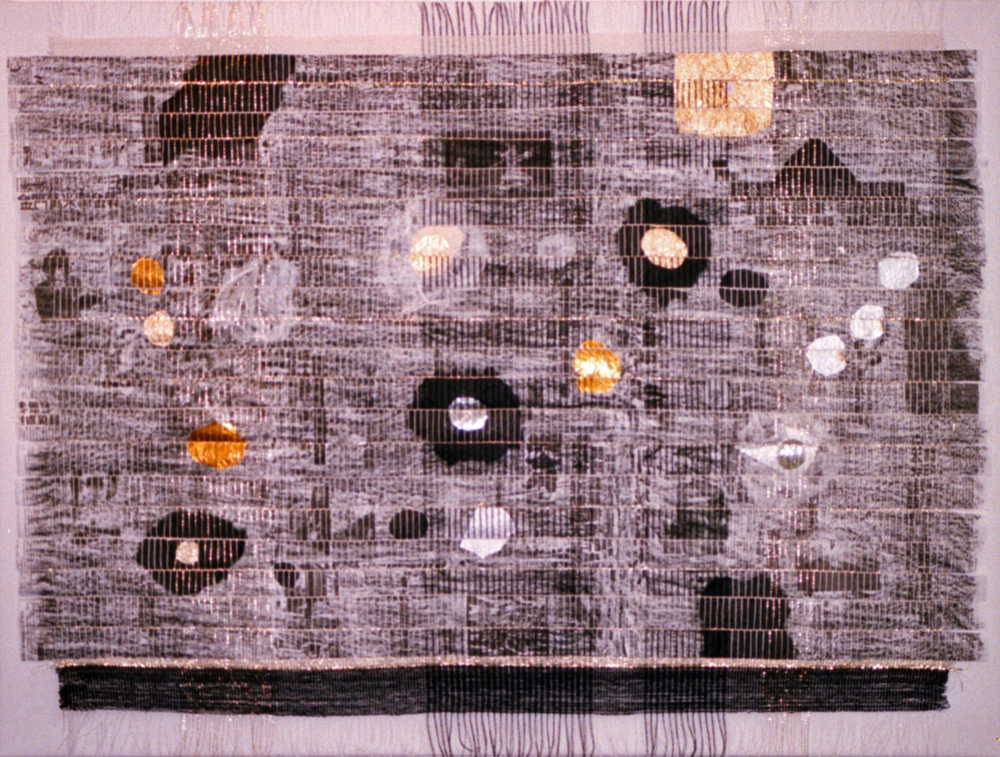
In Black Cosmos, which measures 30” x 40” and was created in 1996, the rigidity of the rectangular format is broken by the unbound warp ends. It is as though the energy of the cosmos could not be contained within a right angled format.Small Cosmos, from the following year, shows Dyer’s continued use of the Taiwanese newspapers as a base for her work. The circle is now a negative space cut out of the paper, a void opening into the background. In Eastern philosophy voids have a psychological intensity which is suggestive of the non material nature of the Tao. Voids also highlight the importance of the relationship between positive and negative space. The balancing of these two forces so that neither overwhelms reflects the synergy of the yin and the yang.2 In the Cosmos series these counteracting forces also include the tension between the regularity of the woven structure and the spontaneity of the surface design.
The non symmetrical composition used in the Cosmos series has freed the circles from the mandala, allowing them to absorb content, becoming stars, suns and black holes. The steady, measured path of the warp under, then over the paper weft binds the celestial orbs with the earthly and mundane reality reported in the newspapers. Instead of forming a uniform and uninterrupted grid over the surface, however, the different colors of the warp disappear and reappear as they cross the drawing and collaged paper. Functionally the warp binds, but conceptually it is fraught with holes. The three dimensional space of the Cosmos has overpowered the two dimensional grid, allowing a freer interaction between the ethereal painted surface and the earthly newspaper.
The dominance of the surface imagery increases through the Cosmos series. In Black Energy Cosmos of 1999 the artist introduces dashed lines. The static woven grid is overpowered by the energy of the drawing. The surface undulates as the drawn lines fly out of and spin back into the voids. This effect is intensified by the use of opposites – the colors black and white and reflective and nonreflective materials. It is the tension of these kinds of oppositions, or dualities that the return to a symmetrical mandala seen in this piece can unify.
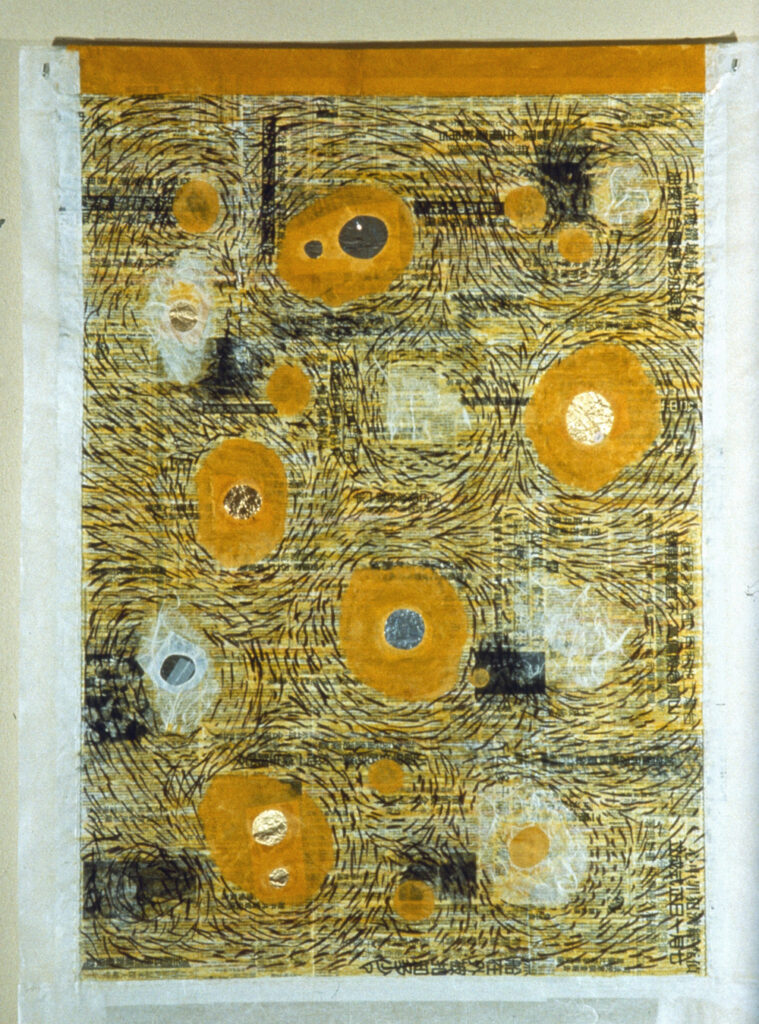
The most recent pieces in the Cosmos series, such as Yellow Cosmos, Sky Flag , approximately 40” x 30” and created in 1998 are collaged together, drawn upon, but never cut into strips and woven. The power of the woven grid to contain the surface imagery has been abandoned, thereby dissipating the tension between the openness of the celestial orbs and the bound nature of weaving. In addition, the density of the drawing masks the earthly reality of the newspaper. In Yellow Cosmos the energy of the radiating dashed lines is unbroken as it speeds around the celestial bodies, setting them spinning. In Blue Cosmos the drawn line has become so dense that it begins to coalesce into circles of its own. The energy in both of these pieces is intense and unbounded, spiraling into, and off of the surface of the work.
At the same time that Dyer’s artistic journey was focusing skyward, she was also noticing changes in the nearer atmosphere. The three weavings on the left, Window II / Gray Sky, Window I / Dark Sky and Window III / Red Sky, also titled Bad Air Day, range from 60” x 36” to 40” x 30”. As part of the Particulate Matter series they reflect the artist’s growing concern with the deterioration of the air quality in her environment. The perspective of this highly distilled image is that of looking out a window at the sky. The window is framed on the bottom by the ends of a scaffolded warp, the actual process of making the work again becoming part of its content. The reduction of the image to two or three rectangles is a calm respite from the spiraling energy of the Cosmos series. This sparseness reflects the gravity of the subject matter, quiet , somber and serious.
The Particulate Matter series is woven from the now familiar Taiwanese newspaper, a particularly well suited material for the subject matter. The printing on the paper produces a gritty, steely gray that suggests the build up of soot and grime. In addition, it is the paper pulp industry that is a major contributor to the declining air quality in Dyer’s surroundings, the Pacific Northwest. Ironically, the artist has woven these pieces with recycled paper. The simplicity of the flat, broad weft traveling under and over the widely spaced thin warp creates a transparent structure that draws attention to the materials. The colored warp adds a subtle variation to the grays – Pacific Northwesterners are astute at reading grays – but the brightness of the red as it protrudes beyond the edges of Window III / Red Sky hints at the artificial, manipulated quality of our surroundings. The exposed warp ends and the bits of paper weft extending beyond the edges suggest the chaos and imbalance that humans introduce into their environment.
The intense mining of the Taiwanese papers as a material continues in the latest works of Dyer. Golden Till and Granite Till both measure 18” x18” and were woven in 2000. Till is a heterogeneous mixture of sand, gravel and rocks deposited by a glacier. It is also a verb that refers to turning the earth, which is just what a glacier does in order to deposit its till. Dyer’s attention has returned to the earth and to a very distilled landscape. The contemplative mood of the quiet colors and the abstracted nature of the images lend these works a meditative and metaphoric quality. The paper in these pieces has been spun to form a kind of paper yarn. The irregularity of the twists and the reflective qualities of the papers suggest the furrowing of newly tilled fields and the golden rows of ripened grain. This use of the materials to develop meaning has been consistent throughout Dyer’s work. Her abstract, minimal aesthetic highlights the power of the materials’ physical qualities to suggest content. This fusion of form and content within the language of abstraction creates a depth to the work that pulls the viewer in, asking for extended contemplation and multiple readings. It is that suggestiveness that has guided my path through Dyer’s work.
Endnotes
1. Jerome Silbergeld, Chinese Painting Style: Media, Methods, and Principles of Form (Seattle: University of Washington Press, 1982) 40-41. The connection between abstraction and the world of the spirit was also promoted by Wassily Kandinsky, Concerning the Spiritual in Art (New York: Dover Publications, 1977). Dyer admits the influence of Kandinsky, whose work was available to her at the Norton Simon Museum in Pasadena, CA.
2. Silbergeld, 48.
